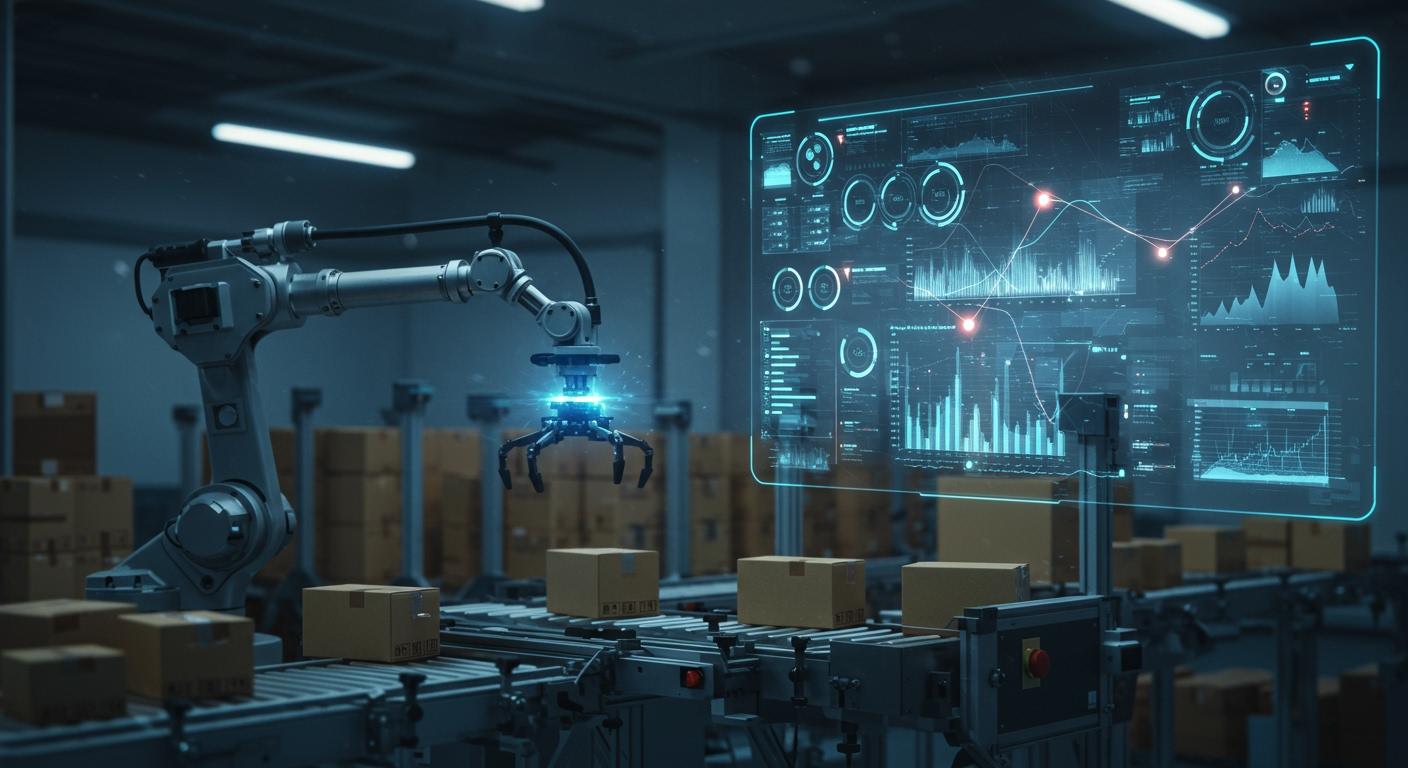
To succeed in 2025 manufacturing, you must abandon static, forecast-based planning. You need a dynamic system that responds to real-time demand signals. AI-driven production scheduling provides the definitive solution for this shift. This AI technology is not just an upgrade; it fundamentally transforms your production floor into an intelligent asset. It enables your operation to navigate modern complexities with new AI scheduling capabilities.
Your production faces constant pressure. Over 53% of leaders anticipate economic headwinds, while 52% worry about supplier reliability. This challenging environment makes optimized scheduling and meeting customer demand difficult.
The Breaking Point of Traditional Scheduling

Your traditional scheduling methods are cracking under modern pressures. The static, forecast-based systems you once relied on cannot keep up with today's manufacturing environment. This inflexibility creates significant risks for your entire operation.
Extreme Demand Volatility
Customer demand no longer follows predictable patterns. This extreme demand volatility makes your annual or quarterly forecast almost instantly obsolete. You face sudden spikes for some products and sharp drops for others. Manual scheduling cannot adjust your production lines fast enough to capture this fluctuating demand, leading to missed sales or excess inventory. The core issue is that your planning is based on history, not on the reality of present-day demand volatility.
Persistent Supply Chain Shocks
Your supply chain faces constant threats. Recent global shocks reduced world trade by 2.7% and industrial production by 1.4% in less than a year. Events like these are now common:
- Canadian wildfires delayed deliveries by up to two days.
- Droughts slowed traffic through the Panama Canal.
- Flash floods in Dubai shut down a major international airport.
Your old systems cannot provide the early supply chain disruption warnings needed to react. This leaves your production vulnerable to sudden halts.
Sustainability and Waste Reduction Mandates
Governments now demand greater environmental responsibility, and your operation must adapt. New regulations require a strong focus on sustainability.
For example, the EU's Waste Framework Directive sets binding food waste reduction targets and requires producers to pay fees based on
sustainabilitycriteria by 2025.
Meeting these sustainability goals requires precise production planning to minimize waste. Your current scheduling struggles to optimize for both efficiency and sustainability, putting you at risk of non-compliance. Achieving your sustainability goals is impossible without a smarter approach to sustainability.
Inefficiencies of Manual Planning
A human planner cannot possibly track every variable in real time. Managing demand volatility, material shortages, machine uptime, and sustainability targets all at once is too complex. This is where an ai system excels. Manual scheduling often results in inefficient resource use, higher operational costs, and delayed orders, showing that a more intelligent solution is necessary.
The Power of AI-Driven Production Scheduling

AI bridges the gap between your factory floor sensors and your execution plan. It transforms raw data into intelligent action. An AI system analyzes multidimensional data points from your operation. It considers equipment status, worker skills, and historical patterns to create the best possible schedules. This turns your production line into a responsive, self-optimizing asset.
AI-Driven Production Planning
Your operation can move beyond the limitations of old planning methods with ai-driven production planning. This technology analyzes your sales, inventory, and capacity data in minutes, not weeks. The ai unifies information from your ERP, MES, and CRM systems. This creates a single source of truth for better decision-making. The result is a plan that improves efficiency and adapts to your business needs.
The differences between an ai-generated plan and a traditional one are significant.
| Feature/Capability | AI-Generated Production Plan | Traditional MRP-Based Plan |
|---|---|---|
| Planning Cycle Time | Up to 90% reduction | Slow, manual, batch planning |
| On-Time Delivery | Over 20% improvement | Suboptimal, errors, missed opportunities |
| Data Analysis | Real-time adaptation | Relies on historical data |
| Adaptability | Adapts in real-time to changes | Less adaptable, batch planning |
Responding to Real-Time Demand Signals
AI-driven production scheduling allows you to listen and react to the market instantly. The system integrates real-time demand signals from many sources. This gives you a true picture of customer demand. Your scheduling no longer relies on outdated forecasts. Instead, it adjusts based on live information.
Your ai system can process signals like:
- Point-of-sale (POS) data from retailers
- Social media trends and online chatter
- Weather patterns affecting consumer behavior
- Competitor pricing changes
- Promotional calendars and marketing events
This capability connects your production directly to market demand, increasing your agility and efficiency.
Dynamic, Constraint-Aware Optimization
Your factory has many moving parts and limitations. AI excels at managing this complexity through dynamic scheduling. The system understands all your operational constraints. It continuously works to find the optimal production path. This process uses advanced analytics and algorithms, like genetic algorithms or reinforcement learning, to balance competing priorities and maximize efficiency.
The ai considers many constraints in real time, including:
- Machine availability and potential breakdowns
- Material shelf life and spoilage risk
- Tooling availability and changeover times
- Labor skills and shift schedules
- Sudden changes in customer
demand
When a rush order arrives or a machine breaks down, the
aican re-optimize your entire schedule in minutes. This keeps your operations nimble and resilient while ensuring all constraints are met.
Predictive Downtime Reduction
Unplanned downtime destroys your production efficiency. AI provides a powerful solution with predictive maintenance. The system uses analytics to forecast equipment failures before they happen. This allows you to schedule maintenance proactively, turning unplanned stops into planned events. Companies using this technology have reduced unplanned downtime by 30% to 50%.
The ai analyzes data from numerous sources to make its predictions:
- Sensors tracking temperature, vibration, and pressure
- Historical maintenance and repair logs
- Real-time performance data from connected assets
- Computer vision that detects wear or misaligned parts
This data-driven approach to maintenance keeps your machines running, your production flowing, and your scheduling on track.
Enabling Mass Customization
Customers today want personalized products. AI-driven production scheduling makes mass customization profitable. It gives you the flexibility to handle small batches and even a "lot size of one" without losing efficiency. The ai can instantly reschedule production to accommodate unique orders. It optimizes task arrangements to minimize setup times and waste.
This technology is already transforming industries:
- Automotive: Car makers use
aito assemble vehicles with unique customer-specified parts and colors on a single production line. - Apparel: Fashion companies leverage
aito create custom garments, with systems generating unique patterns and programming robots for precise sewing.
By embracing ai analytics, you can meet the growing demand for personalization and turn it into a competitive advantage.
Implementation Roadmap: A Phased Approach
Adopting AI scheduling is a journey, not a single leap. You can successfully transform your operations with a structured, phased approach. This roadmap breaks the process into six manageable steps, guiding you from initial assessment to a fully integrated, data-driven culture.
Step 1: Readiness Assessment with AI-Driven Manufacturing Analytics
Before you invest in new technology, you must understand your starting point. A readiness assessment helps you identify your biggest operational challenges and opportunities. You can use ai-driven manufacturing analytics to establish a clear baseline. This initial analysis shows you where an ai system can deliver the most value.
Key operational metrics you should analyze include:
- Time Savings: Hours your team spends creating and adjusting schedules.
- Error Reduction Rate: Frequency of scheduling conflicts and manual corrections.
- Labor Cost Optimization: Amount of overtime pay and overall labor spending.
- Schedule Compliance Rate: Adherence to labor laws and company policies.
- Productivity Improvements: Increases in output from optimized scheduling.
This data gives you a benchmark to measure future success against.
Step 2: Define a Pilot Project with Clear KPIs
You should not try to overhaul your entire factory at once. Instead, start with a focused pilot project. A successful pilot proves the value of ai and builds momentum for wider adoption. Choose a project that targets a significant pain point, like a bottleneck-prone production line or a product family with high demand volatility.
Follow these steps to define your pilot:
- Focus on Pain Points: Identify a specific inefficiency where
aican create a measurable improvement in time, cost, or quality. - Align with Business Goals: Ensure the project supports a larger company objective, such as increasing throughput or reducing production costs.
- Develop a Timeline: Create a realistic schedule with clear milestones and a defined end date.
- Establish Evaluation Metrics: Determine exactly how you will measure success with clear Key Performance Indicators (KPIs).
A well-defined pilot project is conducted in a real-world setting but is limited in scope, making it the perfect testing ground.
Step 3: Select the Right AI Platform
Choosing the right technology partner is critical. The market offers many ai scheduling platforms, but not all will fit your unique needs. Look for a solution that is powerful, user-friendly, and compatible with your existing systems.
Ease of use is a top priority for 75% of users when selecting a new tool. An intuitive interface ensures your team will actually adopt and benefit from the new system.
When comparing platforms, focus on these critical features:
- AI-Powered Capabilities: The system should offer smart suggestions and learn from user habits to improve its accuracy over time.
- Integration Ecosystem: It must connect seamlessly with your other business software, like your ERP, MES, and CRM systems.
- User Experience: The platform needs a simple, clean interface and should be accessible on mobile devices for managers on the go.
A good platform can reduce scheduling time by up to 80%, so this decision has a major impact on your ROI.
Step 4: Execute the Pilot and Measure ROI
With your pilot defined and platform selected, it is time to execute. During the pilot, your team will use the ai system for daily scheduling on the selected production line. Your main goal is to collect data and measure its impact against the baseline you established in Step 1. Calculating the Return on Investment (ROI) is essential to prove the project's value.
You can measure both hard and soft benefits to understand the full picture.
| Basis | Hard Benefits | Soft Benefits |
|---|---|---|
| Meaning | Quantifiable; has a direct financial impact. | Less tangible; critical for long-term success. |
| Metrics | Cost reduction, operational efficiency. | Better customer experience, improved brand equity. |
| Example | The ai system reduces machine downtime by 30%. | An ai chatbot improves customer sentiment. |
To calculate your ROI, you will identify all investment costs, project the net financial benefits, and monitor the results. This analytics-driven approach provides clear proof of the technology's worth.
Step 5: Scale Incrementally Across Lines
A successful pilot gives you the green light to expand. The next step is to scale the ai solution incrementally across other production lines or facilities. This phased rollout minimizes disruption to your overall manufacturing operation and allows you to make adjustments as you go. Use the lessons learned from the pilot to refine your implementation process.
Consider these best practices for scaling:
- Modular Architecture: Build your system with interchangeable components that you can update independently.
- Phased Implementation: Break the scaling project into manageable stages to reduce risk.
- Load Balancing: Distribute scheduling requests across multiple servers to prevent system overloads.
- Performance Baselines: Use advanced manufacturing analytics to establish clear metrics for each new line before and after implementation.
A thoughtful scaling strategy ensures your ai system remains stable and effective as it grows. This is where advanced manufacturing analytics truly shines, providing the analytics needed for a smooth expansion.
Step 6: Foster a Data-Driven Culture
Technology alone cannot transform your organization. You must also foster a culture that values data and empowers employees to use it. This requires strong leadership, ongoing training, and clear communication. When your team understands the "why" behind the change, they are more likely to embrace it.
Effective strategies for building this culture include:
- Leadership Commitment: Leaders must champion the new approach and use advanced manufacturing analytics in their own decision-making.
- Data Literacy Programs: Offer training to enhance your employees' understanding of data basics and
analyticstools. - Continuous Learning: Create opportunities for your team to share experiences and learn from each other.
- Recognize and Incentivize: Reward employees and teams who effectively use data-driven insights to improve performance.
By investing in your people, you ensure that your ai implementation delivers sustainable, long-term value.
Real-World Impact and ROI
The shift to AI scheduling delivers measurable results. You can see tangible value across different industries. These real-world examples show how AI transforms manufacturing operations, boosting efficiency and profitability while advancing sustainability.
Automotive Parts Case Study
In automotive manufacturing, precision is critical. An AI system helps you manage complex supply chains and just-in-time production schedules. It uses analytics to predict parts demand, reducing costly inventory. This ensures you have the right components ready for assembly, which improves production flow and on-time delivery. The result is greater efficiency and a stronger bottom line.
Consumer Packaged Goods Case Study
Your CPG manufacturing operation can gain significant efficiency with AI. One company reduced production setup costs by 22% using AI for its forecast. The system groups similar products based on demand patterns. This optimization leads to fewer changeovers and better production efficiency. AI platforms use advanced analytics to:
- Optimize production sequences to minimize setup times.
- Reduce cleaning time between runs, a key factor for sustainability.
- Use a setup time matrix to find the most efficient production path.
This systematic approach improves your overall efficiency and helps you meet your sustainability goals.
Electronics Manufacturing Case Study
The electronics industry faces rapid product cycles and high demand volatility. AI scheduling gives you the agility to respond. It optimizes your production lines for small, customized batches without losing efficiency. This helps you meet consumer demand for new devices quickly. Better planning also reduces electronic waste, supporting your sustainability goals and improving your brand's reputation.
Demand Forecasting Accuracy Gains
Accurate demand forecasting is the foundation of efficient production. AI models consistently outperform traditional methods. This improvement in demand forecasting accuracy directly impacts your profitability.
| Method | Forecast Accuracy |
|---|---|
| Traditional | 60–75% |
| AI | 85–95% |
A 10-20% improvement in demand forecasting accuracy can reduce your inventory costs by 5% and increase revenue by 2-3%. Advanced demand forecasting with AI provides the analytics you need to make smarter decisions, reduce waste for better sustainability, and capture more sales.
Demand-driven AI production scheduling is a strategic necessity for your 2025 manufacturing operation. You can transform your production from a reactive cost center into an intelligent competitive advantage by embracing AI scheduling. The future of AI promises even greater evolution.
- Your workforce will reskill to collaborate effectively with AI.
- New energy sources will reduce AI costs, making it widespread.
Do not wait for the future to arrive. You must begin your assessment and implementation journey with AI scheduling now to meet market demand and secure your position in manufacturing.
FAQ
How does AI scheduling handle unexpected events?
Your AI system instantly reacts to unexpected events. It uses real-time data from your factory floor. When a machine fails or a rush order arrives, the AI automatically re-optimizes your entire production schedule in minutes. This keeps your operations running smoothly and efficiently.
Is AI scheduling difficult for my team to learn?
Modern AI platforms are designed for ease of use. You can choose a system with a simple, intuitive interface. A phased implementation with proper training helps your team build confidence. They will quickly learn to use the tool to make better scheduling decisions.
Can AI scheduling work with my existing software?
Yes, it can. Leading AI platforms offer strong integration capabilities. They connect seamlessly with your existing Enterprise Resource Planning (ERP) and Manufacturing Execution Systems (MES). This creates a unified data environment for smarter, more accurate planning across your entire operation.
How quickly can I see a return on investment (ROI)?
You can see a positive ROI very quickly. Many companies measure significant gains during the initial pilot project.
For example, you can achieve immediate cost savings through reduced downtime, lower labor costs, and improved on-time delivery rates, proving the system's value early on.
See Also
Predicting Future Market Needs Using AI and Data Insights by 2025
Optimizing Production Forecasts with AI: Enterprise Best Practices for 2024
Intelligent Capacity Planning for Brands: An AI-Powered Strategic Approach
Smart Demand Predictions: AI Tools for Your Upcoming Retail Adventures
Five Essential Real-Time Demand Forecasting Strategies for Business Success